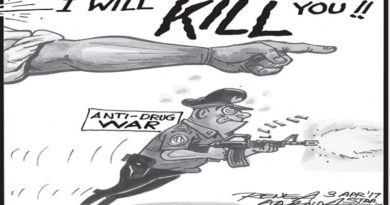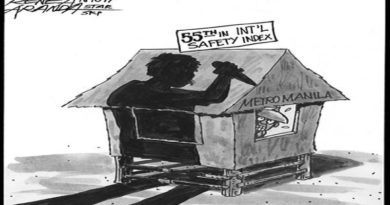OP-ED COLUMNISTS: POSTSCRIPT By Federico D. Pascual Jr. – US on Duterte image: It’s all over media!
Has the American embassy just told President Rodrigo Duterte that any perception of his being a “threat to democracy” is a verdict of public opinion as reflected in the media and not a judgment of the United States government?
It would seem so, based on our reading of the US embassy statement on the meeting Thursday between Executive Secretary Salvador Medialdea and US Ambassador Sung Kim on Duterte’s image as a “threat to democracy.”
When the US Director of National Intelligence released recently its Worldwide Threat Assessment Report lumping Duterte with Southeast Asian leaders seen as threats to democracy, not a few observers presumed that the report culled from US embassy assessments.
Medialdea summoned Kim to clarify the assessment that coincided with similarly unfavorable reports from major points abroad. That Malacañang itself, and not the foreign office, talked to the US ambassador indicated that it was of urgent concern to the President.
The US intelligence report does not yet read like the writing on the wall (mene mene tekel upharsin!), but Duterte would do well to heed it.
As all diplomatic missions do, the US embassy periodically reports to the home office developments that potentially impact on bilateral relations. Coming ahead of the news, such reports also rate the performance of the local leader and where he is taking the nation.
In this cloak and dagger context, ambassadors everywhere are presumed to routinely spy on the host state and lie about their sly operations if necessary. “Spy” and “lie” rhyme, but if they sound sinister, the thesaurus can suggest several euphonic synonyms.
The embassy said Kim explained that the intelligencer was “an annual assessment on conditions in each of the world’s various regions based on widely available information” and that “information about the Philippines had been previously reported by media sources.”
Since the US intelligence community’s view of Duterte jibes with “widely available information,” including some from media, we won’t be surprised if the embassy has a similar assessment of Duterte and his drifting away from democracy.
The report published by Daniel Coats, Director of National Intelligence of the US, zeroed in on drugs, corruption, and crime – the same core problems that Duterte promised during the 2016 presidential election campaign to solve.
By reiterating his commitment to tackling the three problems, Duterte has accepted the challenge to rise or fall on his curbing the drug menace, corruption and criminality on his way to improving the quality of life of Filipinos.
It is uncanny that the rhetoric of the pro and con statements in today’s anniversary of the 1986 People Power Revolt that sent the dictator Marcos scampering to Hawaii also centers on the triangular issues of drugs, corruption and crime under Duterte.
It looks like the issues are joined – but this nation of more than 105 million continues to be fractured along the persona of the former mayor of Davao City catapulted to the presidency in 2016.
• Can’t we fight like Vietnamese?
WITH Beijing taking advantage of the laid-back attitude of the administration on the intrusion of Chinese vessels in Philippine waters – to the extent of militarizing maritime features there – the usual question is why President Duterte is willing to lose territory without putting up a fight.
There is no formal treaty allowing Chinese military bases on Philippine territory, but photographs of Chinese facility built on Philippine islets in violation of the constitutional ban should prompt official reaction from the government, from no less than the President – but no one raises even a whimper.
We remember reading news of Indonesians capturing and blowing up (to teach poachers a lesson) the boats of Chinese fishing in Indonesian waters.
Also remarkable was the resistance by Vietnamese using smaller watercraft to stop the setting up of a Chinese oil rig in Vietnamese waters. The Vietnamese boats were pygmies compared to the Chinese vessels, but they succeeded in driving away the intruders.
Philippine leaders can learn a lesson or two from Vietnam’s marine defense strategy, suggests Roilo Golez, former national security adviser (2001-2004) who has been monitoring Chinese activity in the Philippine EEZ.
Golez, an Annapolis naval academy graduate, noted Vietnam’s long and proud record of dealing with China, its aggressive sea and land neighbor:
1. Vietnam fought a land war with China in 1979 and reportedly gave China’s People’s Liberation Army a bloody nose using only its militia against PLA regulars. (Fighting off Western colonizers, the Vietnamese had also defeated and expelled French and, later, American forces.)
2. In 1988, they had an uneven naval encounter (three Chinese frigates vs two Vietnam transport ships) in the Spratlys (Johnson South Reef) resulting in 64 Vietnamese soldiers and sailors massacred.
3. In 2014, China attempted to bring in a huge oil rig into Vietnam’s EEZ. Vietnam resisted and there was a physical clash, collisions of coast guard ships and fishing vessels. Vietnamese rioted against Chinese facilities in Vietnam. After three months, China withdrew the oil rig.
In spite of these incidents, Golez said, Vietnam has skillfully managed its diplomatic and economic relationships with its neighbors.
When President Duterte was asked why he did not invoke the 2016 award by the UNCLOS-based arbitration tribunal at The Hague invalidating Chinese claim over virtually all of the South China Sea and affirming Philippine rights over features in its EEZ, he said in so many words that he would not want to tangle with China.
* * *
ADVISORY: All Postscripts can be accessed at manilamail.com. Follow author onTwitter as @FDPascual. Email feedback to [email protected].
NOTE : All photographs, news, editorials, opinions, information, data, others have been taken from the Internet ..aseanews.net | [email protected] | For comments, Email to : D’Equalizer | [email protected] | Contributor.











